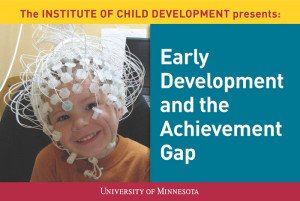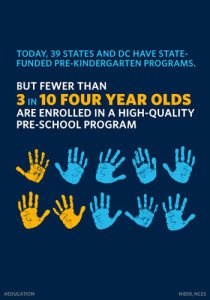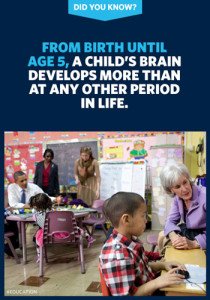Early Childhood Education Articles
USE ERIC TO FIND RESOURCES ABOUT PRESCHOOL
institute of Education Science
Newsflash – 3/12/2014
For most children in the United States, formal education begins before kindergarten. In 2011, 64% of 3- to 5-year-olds attended a preschool program, and there is a growing body of research on the impact of these programs on the development of young children.
ERIC indexes much of the critical research on preschool education. The ERIC digital library has more than 30,000 records about preschool and preschool children, including 4,300 resources with free full text. There are more than 40 What Works Clearinghouse reports on preschool education in ERIC, including intervention reports that summarize the highest quality research, Quick Reviews that provide timely assessments of recent research, and a Practice Guide that provides recommendations for teaching math to young children.
To find preschool resources, you can use the ERIC search feature by entering keywords directly into the search box. You can use the limiters on the left hand side of the page to refine the results. For example, you can use education level limiter to refine a search to only sources that focus on preschool or early childhood education.
You can also browse the Thesaurus for the terms used to tag ERIC records, known as Descriptors. Key Descriptors related to preschool include: Preschool Education, Preschool Children, Preschool Curriculum, Preschool Teachers, Kindergarten, or the broader term Early Childhood Education.
Want more info about ERIC?
Call the ERIC Help Desk at 1-800-LET-ERIC
Sign up for our Newsflash * Like us on Facebook * Follow us on Twitter
EARLY EDUCATION KEY TO FUTURE WORKFORCE
By Lara Magnusdottir
Santa Rosa Press Democrat – 3/07/2014
In his Feb. 23 opinion piece, (“Finding team players in iPod age,”) Paul Gullixson poses the question of how it can be that our county is experiencing both high unemployment and a labor shortage.
The solution, according to panelists on the future workforce at a recent Economic Outlook Conference, is in the local education systems. A study done by oDesk further revealed that part of the problem lies in the high expectations of today’s graduates not having had to “struggle,” and of them lacking the soft skills necessary to be good employees.
We at 4Cs (Community Child Care Council of Sonoma County) would like to offer one high-impact, longterm solution to this crisis: early childhood education. As providers of subsidized preschool services to low-income families, we experience every day how important it is that children start their school careers prepared. This may sound strange to those of us who are now adults and may remember a kindergarten very different from today’s fast-paced classroom for 5 year olds.
The fact is that children who have not yet experienced functioning in a classroom setting start kindergarten already behind their peers. They spend their first months learning how to sit quietly in a circle, to raise their hand and wait their turn, to follow two- and three-step directions, to get along with others and to be away from their parents for a stretch of four to five hours. Some children enter kindergarten not knowing how to cut with scissors or hold a pencil. Disadvantaged children start kindergarten with half the vocabulary of their affluent peers and often lack the character skills to thrive in school.
Studies have shown that high-quality early childhood education increases employability by 23 percent and that a child educated in her first five years is 70 percent less likely to be arrested for a violent crime. Analysts of the Chicago Child-Parent Center study estimate $48,000 in benefits to the public per child from a half-day public preschool for at-risk children. Other studies have found that the estimated return on investment is $7 for every dollar invested.
We hear a lot of talk these days about the achievement gap or opportunity gap. We hear that the difference between the “haves” and the “have-nots” continues to increase. We also hear that in California, 50 percent of children never go to preschool. The key issue is that the children who need it the most are the ones who don’t have the opportunity to have a positive education experience before kindergarten. These children begin their school experience behind, and many never catch up.
If we were to prepare these children to be ready to succeed from the beginning, their chances of successfully making it through their education increase exponentially. This would help bring a group of young people into the mix of our future workforce, young people who are not in the usual “have” group and who have experienced their share of struggle.
But it’s not just the children who need an education. Family engagement is an essential component and is provided in currently existing subsidized preschool programs. All parents want the best for their children. Parents who have never themselves received support or been successful in their educational careers will benefit from guidance on how to help their children succeed in school and how to be an active participant in their child’s education. And when is the best time to provide that guidance? The earlier, the better, of course.
And just think, the children in our preschool programs today will graduate high school in only 14 years.
Lara Magnusdottir is resource and referral director for the Community Child Care Council of Sonoma County.
STUDY FINDS INCOME-LINKED LANGUAGE GAP
By Motoko Rich
New York Times – 10/22/2013
Nearly two decades ago, a landmark study found that by age 3, the children of wealthier professionals have heard words millions more times than those of less-educated parents, giving them a distinct advantage in school and suggesting the need for increased investment in prekindergarten programs. Now a follow-up study has found a language gap as early as 18 months, heightening the policy debate.
 The new research by Anne Fernald, a psychologist at Stanford University, which was published in Developmental Science earlier this year, showed that at 18 months, children from wealthier homes could identify pictures of simple words they knew — “dog” or “ball” — much faster than children from low-income families. By age 2, the study found, affluent children had learned 30 percent more words in the intervening months than the children from low-income homes.
The new research by Anne Fernald, a psychologist at Stanford University, which was published in Developmental Science earlier this year, showed that at 18 months, children from wealthier homes could identify pictures of simple words they knew — “dog” or “ball” — much faster than children from low-income families. By age 2, the study found, affluent children had learned 30 percent more words in the intervening months than the children from low-income homes.
The new findings, although based on a small sample size, reinforced the earlier research showing that, because professional parents speak so much more to their children, their children hear 30 million more words by the time they are 3 than children from low-income households, early literacy experts, preschool directors and pediatricians said.
In the new study, the children of affluent households came from communities where the median income was $69,000; the low-income children came from communities with a median income of $23,900.
Since oral language and vocabulary are so connected to reading comprehension, the most disadvantaged children face increased challenges once they enter school and start learning to read. “That gap just gets bigger and bigger,” said Kris Perry, executive director of the First Five Years Fund, an advocate of early education for low-income children. “That gap is very real and very hard to undo.”
enter school and start learning to read. “That gap just gets bigger and bigger,” said Kris Perry, executive director of the First Five Years Fund, an advocate of early education for low-income children. “That gap is very real and very hard to undo.”
The National Governors Association, in a report this month calling on states to ensure that all children can read proficiently by third grade, urges lawmakers to increase access to high-quality child care and prekindergarten classes and to invest in programs for children from birth through age 5.
“A lot of states are saying, let’s get to the early care providers and get more of them having kids come into kindergarten ready,” said Richard Laine, director of education for the National Governors Association. That way, he said, “We’re not waiting until third grade and saying ‘Oh my gosh, we have so many kids overwhelming our remediation system.”
WHAT YOU NEED TO KNOW ABOUT PRESIDENT OBAMA’S PLAN TO PROVIDE HIGH-QUALITY EARLY EDUCATION FOR ALL CHILDREN
Megan Slack
February 14, 2013
“In states that make it a priority to educate our youngest children…studies show students grow up more likely to read and do math at grade level, graduate high school, hold a job, form more stable families of their own. We know this works. So let’s do what works and make sure none of our children start the race of life already behind.”
President Barack Obama, State of the Union, February 12, 2013
The beginning years of a child’s life are critical for building the early foundation needed for success later in school and in life. Leading economists agree that high-quality early learning programs can help level the playing field for children from lower-income families on vocabulary, social and emotional development, while helping students to stay on track and stay engaged in the early elementary grades. Children who attend these programs are more likely to do well in school, find good jobs, and succeed in their careers than those who don’t.
Despite the benefits of early education, our nation has lagged in making sure high-quality programs are available for our youngest kids. While 39 states and the District of Columbia offer state funded pre-school, the Organization of Economic Cooperation and Development estimates that the United States ranks 28th out of 38 countries for the share of four-year olds enrolled in early childhood education. And just 3 in 10 four-year-olds are enrolled in high-quality programs that prepare kids with the skills they need for kindergarten.
In particular, studies show that children from low-income families are less likely to have access to high-quality early education, and less likely to enter school prepared for success. By third grade, children from low-income families who are not reading at grade level are six times less likely to graduate from high school than students who are proficient. And the high costs of private preschool and lack of public programs also narrow options for middle-class families.
That’s why, in his State of the Union address, President Obama called on Congress to expand access to hi-quality pre-school to every child in America.
The President is proposing a new federal-state partnership to provide all low- and moderate-income four-year old children with high-quality preschool. His proposal will also expand access to high-quality preschool for children from middle class families and incentivizing full-day kindergarten policies.
 Under his proposal, the U.S. Department of Education would allocate dollars to states based their share of four-year olds from low- and moderate-income families (those at or below 200% of the poverty line) and funds would be distributed to local school districts and other partner providers to implement the program. In order to access federal funding, however states would be required to meet quality benchmarks that are linked to better outcomes for children, include:
Under his proposal, the U.S. Department of Education would allocate dollars to states based their share of four-year olds from low- and moderate-income families (those at or below 200% of the poverty line) and funds would be distributed to local school districts and other partner providers to implement the program. In order to access federal funding, however states would be required to meet quality benchmarks that are linked to better outcomes for children, include:
- State-level standards for early learning
- Qualified teachers for all preschool classrooms
- A plan to implement comprehensive data and assessment systems
Funds under this program may also be used to expand full-day kindergarten once states have provided preschool education to their low- and moderate-income students.
The President’s proposal will also help expand the availability of Early Head Start, which provides early learning opportunities before kids begin preschool, as well as voluntary home visiting programs. Home visiting programs enable nurses, social workers, and other professionals to connect families to services and educational support that will improve a child’s health, development, and ability to learn.

Recent Comments